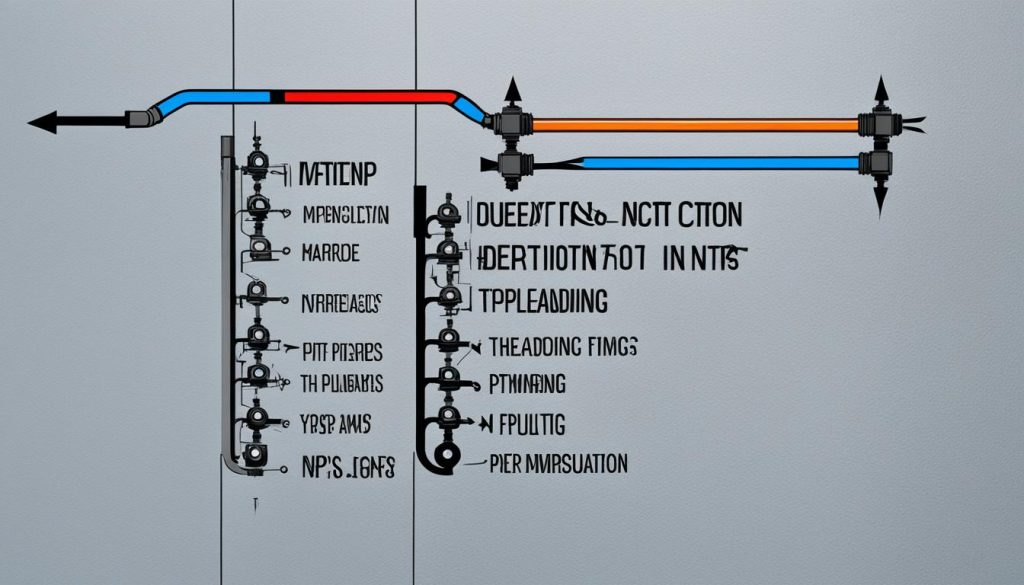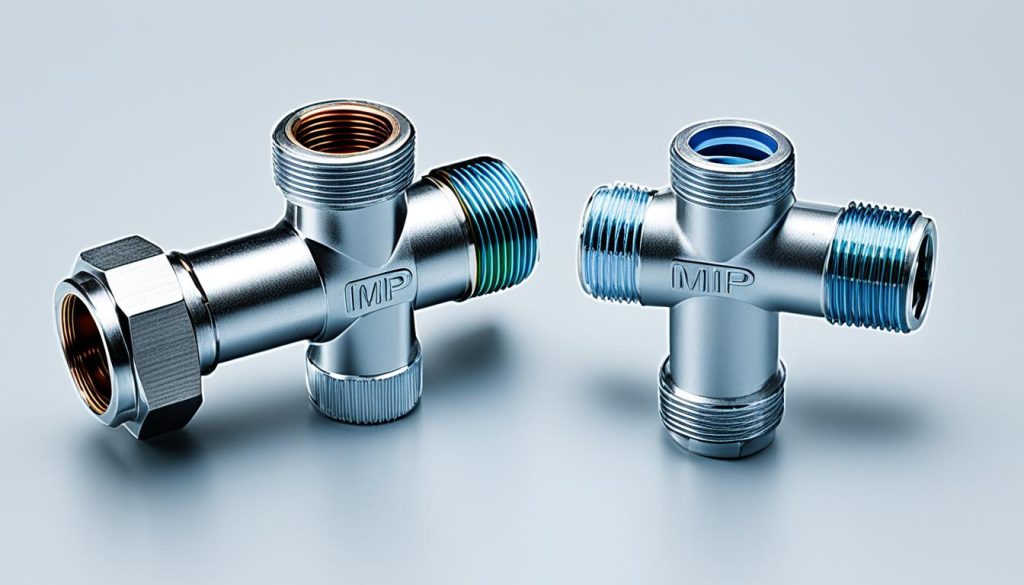Understanding FIP Plumbing Meaning – Quick Guide
Did you know that FIP, or Female Iron Pipe, fittings are a crucial component in plumbing systems?
When it comes to connecting pipes and other plumbing components, FIP fittings play a vital role in ensuring a tight seal and a reliable connection. But what exactly does FIP stand for, and how does it differ from MIP fittings? In this quick guide, I’ll explain the meaning of FIP plumbing, its fittings, and the important differences you need to know.
Key Takeaways:
- FIP stands for Female Iron Pipe and is a type of fitting used in plumbing.
- FIP fittings have threads on the inside, while MIP fittings have threads on the outside.
- Understanding the meaning and usage of FIP fittings is essential for plumbing projects.
- FIP fittings are commonly made of materials like iron, steel, or brass.
- FIP fittings are used to connect pipes and other plumbing components, providing a tight seal.
Common Pipe Thread Types in Plumbing
In plumbing, various types of pipe thread are commonly used to ensure proper fittings and connections. Understanding these thread types is crucial for a successful plumbing project. Let’s explore some of the common pipe thread types:
NPT (National Pipe Tapered or Straight)
The NPT thread type, also known as National Pipe Tapered or Straight, is widely used in North America. It features a tapered design and is available in various sizes. NPT threads are compatible with both MIP (Male Iron Pipe) and FIP (Female Iron Pipe) threads and are commonly used in plumbing, gas transportation, and hydraulic applications.
NPS (National Pipe Straight)
NPS, or National Pipe Straight, is another common thread type found in North America. Unlike NPT, NPS threads have a straight design without tapering. NPS threads have the same dimensions as MIP and FIP threads and are used for specific applications where tapering is not required.
BSP (British Standard Pipe Tapered or Straight)
BSP, or British Standard Pipe, is the thread type predominantly used in Europe. It comes in both tapered (BSPT) and straight (BSPP) variants. BSP threads have rounded crests and troughs and are measured in metric units. When working with plumbing systems in Europe or other countries that follow the BSP standard, familiarity with BSP threads is essential.
UNF (Unified National Fine) and UNC (Unified National Coarse)
Unified Special Thread (UNS) is the general thread standard used in the United States and Canada for screws, nuts, and bolts. UNC and UNF are two thread types under the UNS series. UNC refers to Unified National Coarse threads, which have larger thread sizes, fewer threads per inch (TPI), and a wider pitch. UNF, on the other hand, stands for Unified National Fine threads, which have smaller thread sizes, more threads per inch, and a finer pitch.
| Thread Type | Description |
|---|---|
| NPT | National Pipe Tapered or Straight |
| NPS | National Pipe Straight |
| BSP | British Standard Pipe Tapered or Straight |
| UNF | Unified National Fine |
| UNC | Unified National Coarse |
Understanding the different common pipe thread types will help you select the appropriate fittings and connectors for your plumbing system. Whether you’re working on a project in North America, Europe, or other regions, having the correct thread type is crucial for achieving leak-free and secure connections.
NPT and NPS Thread Definitions
When it comes to pipe threads used in the United States, NPT (National Pipe Tapered) and NPS (National Pipe Straight) are the most common standards. These threaded connections provide a secure and leak-proof seal, making them ideal for various plumbing, hydraulic, and gas transportation applications. Let’s take a closer look at the definitions and characteristics of NPT and NPS threads.
Tapered Threads
NPT threads are tapered, which means they gradually get smaller in diameter towards the end of the pipe. This tapering design helps create a tighter seal when the fitting is tightened. The taper angle for NPT threads is 1°47′, ensuring a reliable connection and preventing leaks.
Straight Threads
In contrast, NPS threads are straight and have a uniform diameter throughout the length of the pipe. While they don’t offer the same sealing capabilities as tapered threads, they are commonly used in non-sealing applications or situations where a gasket or sealant is used to ensure a leak-proof connection.
Thread Angle and Pitch
Both NPT and NPS threads have a 60° angle between the flat crests and troughs of the threads. This angle allows for easy engagement and disengagement of the fittings. Another important aspect of pipe threads is the pitch, which is measured in threads per inch (TPI) for NPT and NPS fittings.
For a better understanding of the different thread sizes, refer to the NPT thread size chart below:
| NPT Size | TPI (Threads per Inch) |
|---|---|
| 1/8″ | 27 |
| 1/4″ | 18 |
| 3/8″ | 18 |
| 1/2″ | 14 |
| 3/4″ | 14 |
| 1″ | 11.5 |
Understanding the definitions and characteristics of NPT and NPS threads is crucial when working with pipe fittings. Whether you need a tight seal with tapered threads or a non-sealing connection with straight threads, knowing the thread dimensions and sizes will ensure a proper fit and reliable plumbing system.
MIP and FIP Thread Definitions
In the world of plumbing, MIP (Male Iron Pipe) and FIP (Female Iron Pipe) fittings play an essential role in connecting pipes and ensuring a tight seal. Understanding the definitions and differences between MIP and FIP is crucial for selecting the right fitting for your plumbing needs.
MIP fittings have male threads on the outside. They are designed to be inserted into other fittings, such as valves or couplings, with female threads. The male threads on MIP fittings are tapered to create a secure connection and prevent leaks.
FIP fittings, on the other hand, have female threads on the inside. They are typically used to receive MIP fittings or other male-threaded components. FIP fittings are also tapered to ensure a reliable and watertight connection.
It’s worth noting that despite their names, MIP and FIP fittings are not limited to being made of iron. They can be constructed from various materials, including steel and brass, depending on the specific application and requirements.
To summarize:
| MIP (Male Iron Pipe) | FIP (Female Iron Pipe) |
|---|---|
| Male threads on the outside | Female threads on the inside |
| Tapered for a tight seal | Tapered for a tight seal |
| Variety of materials (steel, brass, etc.) | Variety of materials (steel, brass, etc.) |
BSP Thread Definitions
When it comes to pipe fittings, it’s important to have a clear understanding of thread definitions. In this section, I will explain the basics of BSP (British Standard Pipe) threads and their significance in plumbing systems.
BSP threads are widely used in the UK, Australia, and other Commonwealth countries as the standard for pipe fittings. These threads have rounded crests and troughs, providing a secure connection between pipes and fittings. One notable feature of BSP threads is the 55° angle between the crest and trough. This unique angle ensures a reliable seal that can withstand pressure and prevent leaks.
There are two main types of BSP threads:
- BSPP (parallel or straight) threads: These threads have a constant diameter throughout the fitting, allowing for a tight and secure connection. They are commonly used in applications where a watertight connection is required.
- BSPT (tapered seal) threads: In contrast to BSPP threads, BSPT threads have a tapered design that creates a seal by wedging the threads together. This taper seal ensures a leak-free connection and is often used in applications where a secure seal is critical, such as gas pipelines.
By understanding the thread definitions and characteristics of BSP fittings, plumbers and DIY enthusiasts can confidently select and install the appropriate fittings for their plumbing systems. Now that we have covered BSP threads, let’s move on to exploring another important thread type in the next section.
UNS Thread Definitions
When it comes to pipe threads in the United States and Canada, the Unified Special Thread (UNS) is the standard. UNS threads are widely used for screws, nuts, bolts, and other threaded components. These threads have a 60° angle between the crests and troughs, similar to NPT threads.
In the UNS series, there are various thread types available for different applications:
- UNC (Unified National Coarse): This thread type features a coarse pitch and is commonly used for general-purpose applications where strength and durability are important.
- UNF (Unified National Fine): UNF threads have a finer pitch and are ideal for applications that require a more precise fit or when dealing with softer materials.
- UNEF (Unified National Extra Fine): UNEF threads have an even finer pitch, making them suitable for delicate applications or situations where minimal thread engagement is required.
- UN (Unified National): UN threads have a fixed pitch and are commonly found in specialized applications, such as aerospace or automotive industries.
Understanding the differences between these UNS thread definitions is crucial for selecting the appropriate thread type for your plumbing projects. It ensures a secure and reliable connection between components.
| Thread Type | Thread Pitch | Applications |
|---|---|---|
| UNC (Unified National Coarse) | Coarse | General-purpose applications |
| UNF (Unified National Fine) | Fine | Precise fit, softer materials |
| UNEF (Unified National Extra Fine) | Extra Fine | Delicate applications, minimal thread engagement |
| UN (Unified National) | Fixed Pitch | Specialized applications |
Tips for Working with Pipe Fittings
When it comes to working with pipe fittings, following a few essential tips can make a world of difference in ensuring a successful installation. Here are some important guidelines to keep in mind:
Avoid cross-threading: Inserting a fitting at an angle can damage the threads and lead to leaks. Be sure to align the fitting properly before tightening.
Opt for Teflon tape: Instead of using pipe dope, consider using Teflon tape for a smoother and easier installation. This will also prevent excess sealant from flowing into appliances and causing potential issues.
Keep fittings clean: Before using any fittings, make sure to thoroughly clean the ends to avoid any debris or unwanted particles from getting caught in the threads. This will help to ensure a proper and secure connection.
Don’t overtighten: It’s important to avoid overtightening fittings, especially when working with plastic materials. Over-tightening can result in cracking or splitting of the fitting, leading to leaks or other complications.
Know your fitting types: There are various types of pipe thread fittings, including couplings, unions, nipples, tees, elbows, bushings, and barbs. Understanding the specific role and function of each fitting type will help you choose the right one for your project.
Consider compression fittings: Compression fittings are a special type of fitting that doesn’t match with any other thread type. They are commonly used for soft copper pipes and small-diameter tubing, providing a reliable and secure connection.
By following these pipe fitting tips and having a good understanding of the different types of fittings, you can ensure a smooth and successful plumbing project.
Source Links
- https://www.certifiedaccessories.com/blogs/news/solving-the-mystery-of-plumbing-abbreviations
- https://www.freshwatersystems.com/blogs/blog/how-to-determine-pipe-thread-type-and-pipe
- https://www.spotix.com/blog/everything-about-pipe-thread-sizing
- Investing Wisely: How Windows & Doors in Boost Property Value and Financial Health - April 24, 2025
- The Financial Impact of Personal Injuries: Why Legal Help Matters for Business Owners - April 16, 2025
- The Hidden Financial Costs of Domestic Assault: What Business Owners Need to Know - April 16, 2025













